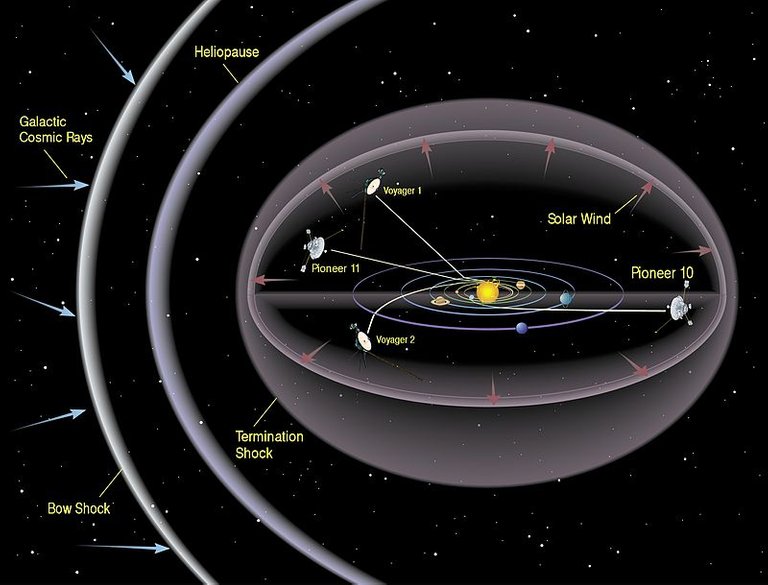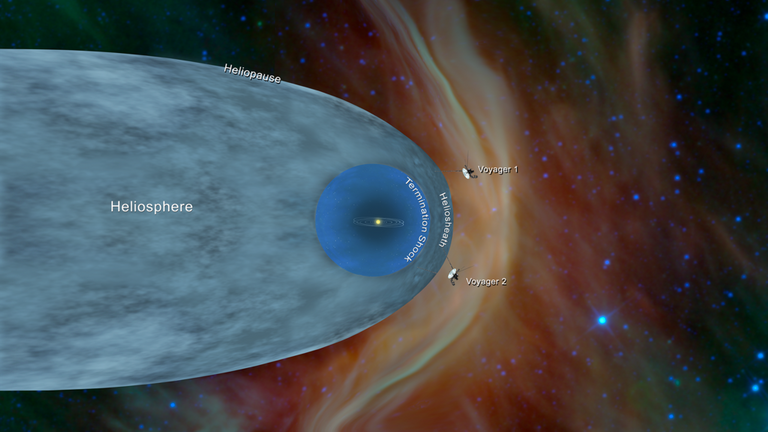Our solar system is very extensive, more than many imagine, it does not end with Neptune as we usually represent in school models, but beyond, at a point where the solar wind joins the interstellar medium, that point is defined as the heliopause.

Graphical representation of the heliopause. Source: Wikipedia.org.
This heliopause marks the boundary between the heliosphere, the region of space under the influence of our sun and its magnetic field, and interstellar space, which is the vast space between the stars. This boundary is where the pressure of the solar wind is lost due to its radial diffusion, equalizing the pressure of the interstellar medium, its distance from the sun is not precisely known, but it is assumed to be smaller towards the direction in which the sun moves in the galaxy, so it has been theoretically given a teardrop shape.
Now, something unforeseen seems to be happening in this theoretical limit of our solar system, the heliopause seems to be undulating and forming angles that until now were not thought possible. Although the idea that the heliopause can change its shape was conceived, it is only now, thanks to data obtained by the Voyager 1 and Voyager 2 probes, the only space probes to reach the edge of the solar system, in 2004 and 2007 respectively, and with data collected by the IBEX (Interstellar boundary Explorer) satellite, that it has been confirmed that this edge is neither static nor symmetrical.
The Voyager space probes have provided important data from the heliopause, providing in situ data, the only direct measurements that have been obtained, however, were only data from their locations on this boundary, which represents very few points in space and time, but with the IBEX satellite, a group of scientists from Princeton University have managed to complete the measurements. The conclusions of their study were recently published in the journal Nature Astronomy.

Diagram of the heliosphere. Source: Wikipedia.org.
Previous analyses have shown that the structure of the heliosphere can be determined by correlations between the evolution of the solar wind pressure and the energetic neutral atom (ENA) brightness, and in this study, measurements of the dynamic solar wind pressure obtained from the Interstellar Boundary Explorer were used to create models of the three-dimensional distances of the heliospheric termination shock and the heliopause. And basically they have found that the interaction between the solar winds and the interstellar medium pushes and squeezes the haliopause creating a constantly moving boundary.
Their findings reveal wavy surfaces of the heliosphere and heliopause, oblique to the solar wind direction and with significant asymmetries in the structure of the heliosphere. Establishing that the boundaries of the heliosphere can contain up to ten spatial variations of the size of an astronomical unit.
In short, the shape of the heliopause changes dramatically, but it has not been clearly established why. Although the results would provide an explanation as to why so much time elapsed between the Voyager probes' entries into interstellar space, with Voyager 1 doing so in 2013 and Voyager 2 in 2018, each being launched from Earth within days of each other in 1977.
This team of scientists will continue to study the heliopause with the data collected from IBEX, while NASA prepares the launch of the Interstellar Mapping and Acceleration Probe (IMAP) scheduled for 2025, a new satellite equipped with ENA cameras with a higher resolution than those of IBEX, with which these researchers hope to continue discovering the mysteries of the edge of our solar system.
Well friends, let's hope that the next data will help us to continue discovering the limits of our solar system. See you next time!
References
Wikipedia.org. Heliosphere.
Zirnstein, E.J., Shrestha, B.L., McComas, D.J. et al. Oblique and rippled heliosphere structures from the Interstellar Boundary Explorer. Nat Astron (2022).
I didnt know that it was such a different thing and it had really a boundary
!1UP
No doubt there are many mysteries to be discovered in our solar system.
You have received a 1UP from @gwajnberg!
@stem-curator, @vyb-curator, @pob-curator
And they will bring !PIZZA 🍕.
Learn more about our delegation service to earn daily rewards. Join the Cartel on Discord.
Thanks!